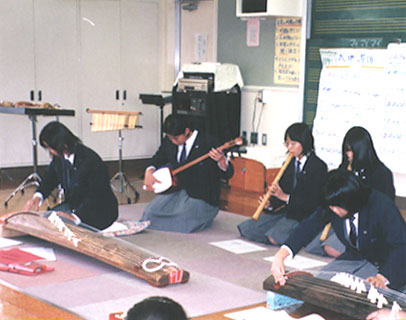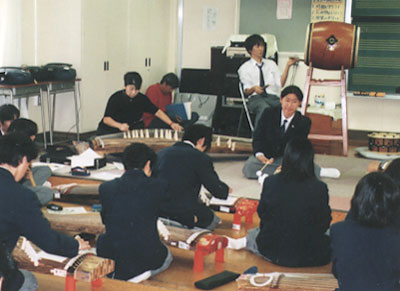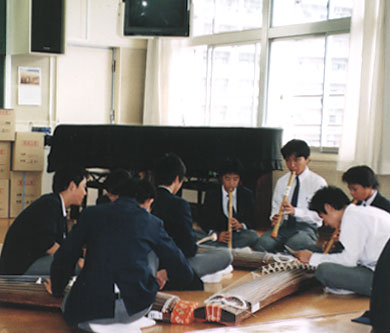|
Koto, shamisen, shakuhachi (bamboo flute), wadaiko (Japanese drum), fue (another kind of flute), hichiriki (bamboo oboe). . . all of these are very old Japanese musical instruments with a history of more than 1,000 years. Even many adults probably don't know what they are. But beginning in April 2002, National Curriculum Standards will require all students in Japan to study how to play at least one of these traditional instruments throughout their three years of music classes in middle school.
Even many music teachers are not familiar with traditional Japanese music; they are now quite busy gathering instruments for class and undertaking training themselves. Some books for schools have been published that allow children to perform Japanese folk songs and children's songs while reading Western staff notation, which is easier than a traditional Japanese score.
 To find out more about the new attempt to introduce these instruments to children, we talked to Hiromi Shimizu, a music teacher at Fussa Second Junior High School, where children have been learning how to play Japanese instruments for the past 10 years. Shimizu says, "When kids come into the music room and see all of the kotos lined up, they look absolutely amazed. When they actually play the koto, they say things like 'It sounds beautiful and makes me feel calm,' or 'Even though I'm Japanese, I didn't know anything about Japanese music. I'm glad I learned so much.'"
To find out more about the new attempt to introduce these instruments to children, we talked to Hiromi Shimizu, a music teacher at Fussa Second Junior High School, where children have been learning how to play Japanese instruments for the past 10 years. Shimizu says, "When kids come into the music room and see all of the kotos lined up, they look absolutely amazed. When they actually play the koto, they say things like 'It sounds beautiful and makes me feel calm,' or 'Even though I'm Japanese, I didn't know anything about Japanese music. I'm glad I learned so much.'"
 First-year students at Fussa Second Junior High School learn to play the Japanese folk song "Sakura sakura" on the koto. In addition to continuing with the koto, second-year students also try the shakuhachi. Following their study of Kabuki (a kind of Japanese drama), third-year students get a taste of playing the shamisen. Shimizu says, "The students adapt quite well. They've played the recorder before, so they can blow into the shakuhachi, and they get good at the shamisen quite quickly by thinking of it as similar to the guitar."
First-year students at Fussa Second Junior High School learn to play the Japanese folk song "Sakura sakura" on the koto. In addition to continuing with the koto, second-year students also try the shakuhachi. Following their study of Kabuki (a kind of Japanese drama), third-year students get a taste of playing the shamisen. Shimizu says, "The students adapt quite well. They've played the recorder before, so they can blow into the shakuhachi, and they get good at the shamisen quite quickly by thinking of it as similar to the guitar."
 Playing Japanese instruments like the koto, shakuhachi, wadaiko, and mokugyo (wood blocks) in an ensemble with such Western instruments as the glockenspiel, wind chimes, and castanets is hugely popular among the students. In addition to such folk songs as "Tokyo Ondo" and "Soran-bushi," they play the theme songs of their favorite anime movies, such as Princess Mononoke and Spirited Away.
Playing Japanese instruments like the koto, shakuhachi, wadaiko, and mokugyo (wood blocks) in an ensemble with such Western instruments as the glockenspiel, wind chimes, and castanets is hugely popular among the students. In addition to such folk songs as "Tokyo Ondo" and "Soran-bushi," they play the theme songs of their favorite anime movies, such as Princess Mononoke and Spirited Away.
Some third-year students at the school, who have three years of experience with Japanese instruments, shared their opinions with us. One student commented, "Japan has such great music!" Another student noted that "Japanese instruments are played differently than the piano or the guitar. They may look easy, but they're actually difficult." A third student said, "I was able to learn how great all these instruments are. I think the shakuhachi is awesome!" Through their studies, these students have begun to take pride in Japanese culture. At the same time, they are creating a new world of music as they enjoy freely mixing Japanese and Western instruments.
Photos: (Top) Students play, from left, the Koto, Shamisen, and Shakuhachi; (Middle) Students enjoy playing traditional instruments together; (Bottom) Everyone practices their instruments diligently. (Hiromi Shimizu)
(Some material taken from Supplementary Materials by Hiromi Shimizu.)
|

 To find out more about the new attempt to introduce these instruments to children, we talked to Hiromi Shimizu, a music teacher at Fussa Second Junior High School, where children have been learning how to play Japanese instruments for the past 10 years. Shimizu says, "When kids come into the music room and see all of the kotos lined up, they look absolutely amazed. When they actually play the koto, they say things like 'It sounds beautiful and makes me feel calm,' or 'Even though I'm Japanese, I didn't know anything about Japanese music. I'm glad I learned so much.'"
To find out more about the new attempt to introduce these instruments to children, we talked to Hiromi Shimizu, a music teacher at Fussa Second Junior High School, where children have been learning how to play Japanese instruments for the past 10 years. Shimizu says, "When kids come into the music room and see all of the kotos lined up, they look absolutely amazed. When they actually play the koto, they say things like 'It sounds beautiful and makes me feel calm,' or 'Even though I'm Japanese, I didn't know anything about Japanese music. I'm glad I learned so much.'" First-year students at Fussa Second Junior High School learn to play the Japanese folk song "Sakura sakura" on the koto. In addition to continuing with the koto, second-year students also try the shakuhachi. Following their study of Kabuki (a kind of Japanese drama), third-year students get a taste of playing the shamisen. Shimizu says, "The students adapt quite well. They've played the recorder before, so they can blow into the shakuhachi, and they get good at the shamisen quite quickly by thinking of it as similar to the guitar."
First-year students at Fussa Second Junior High School learn to play the Japanese folk song "Sakura sakura" on the koto. In addition to continuing with the koto, second-year students also try the shakuhachi. Following their study of Kabuki (a kind of Japanese drama), third-year students get a taste of playing the shamisen. Shimizu says, "The students adapt quite well. They've played the recorder before, so they can blow into the shakuhachi, and they get good at the shamisen quite quickly by thinking of it as similar to the guitar." Playing Japanese instruments like the koto, shakuhachi, wadaiko, and mokugyo (wood blocks) in an ensemble with such Western instruments as the glockenspiel, wind chimes, and castanets is hugely popular among the students. In addition to such folk songs as "Tokyo Ondo" and "Soran-bushi," they play the theme songs of their favorite anime movies, such as Princess Mononoke and Spirited Away.
Playing Japanese instruments like the koto, shakuhachi, wadaiko, and mokugyo (wood blocks) in an ensemble with such Western instruments as the glockenspiel, wind chimes, and castanets is hugely popular among the students. In addition to such folk songs as "Tokyo Ondo" and "Soran-bushi," they play the theme songs of their favorite anime movies, such as Princess Mononoke and Spirited Away.